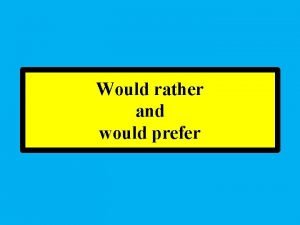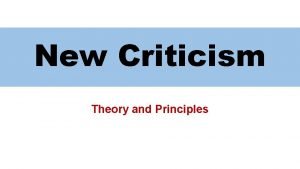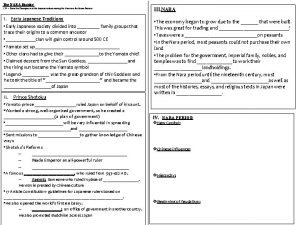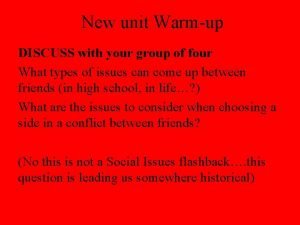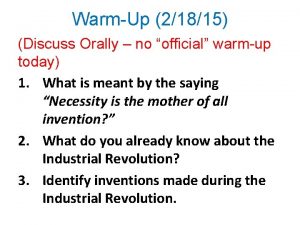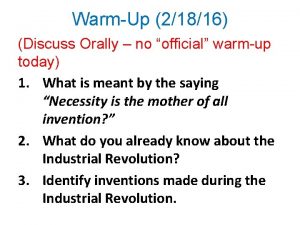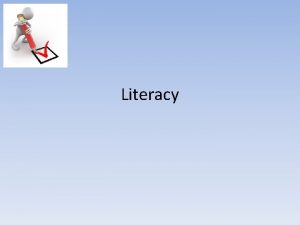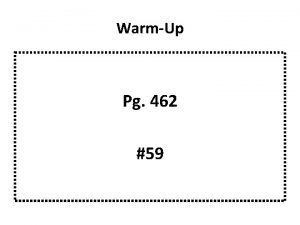New unit warmup Consider and discuss Would you

















- Slides: 17

New unit warm-up: Consider and discuss: Would you rather live in a society where there are strict rules and control (=less personal freedoms) or one where there are no rules weak leaders (and lots more personal freedoms)? What would be the pros and cons of these types of societies?

The Rise of Totalitarianism After WWI, people were willing to accept rule by dictators who controlled all aspects of society. In the 1920 s and 1930 s Russia, Italy and Germany produced three of history’s most infamous men. In this unit we will explore WHY this occurred and how these men exerted their authority. Totalitarianism: A type of rule where the leader exerts total control (political, social, economic, emotional) over their people.

New Unit Calendar!

By studying the rise of these dictators and their methods and personality, we are also prompted to examine aspects of human nature that are less than optimistic, such as the nature and cause of evil, aggression, control. Joseph Stalin Benito Mussolini Adolf Hitler

Keep considering…. What do you know about these country’s experience in WWI? Russia Italy Germany Why might that be significant to their post WWI choice of leaders?

Totalitarianism Case Study #1: Russia Stalin’s story begins before Stalin… In 1917 Russia will throw off 300 years of rule by the Czar and have a communist revolution. Take notes on Assignment #1: The Russian Revolution and the Rise of Stalin

FROM Czar Nicholas II Absolute Monarch TO Vladimir Lenin Communist leader The Russian Revolution of 1917

300 Years of Absolute Monarchy in Russia (1613 – 1917) • Renaissance & Enlightenment ideas never spread to Russia • Romanov Family ruled as virtual dictators for 300 years (Tsar or Czar = Caesar) • No legislative body, no constitution, no voice for the people that Czar had to follow • Inequality led to periodic uprisings & revolts that were crushed violently The Romanovs

Russia on the eve of revolution • Huge & Intolerant – Largest nation in world, lots of natural resources – Most of population poorly educated peasant farmers called serfs – Russian Orthodox Church very powerful – Execution of dissidents –those with different views, religions, ethnicities • Not Modern – Outdated agricultural practices often led to high prices & food shortages – Few mechanized , modern factories – Lagged far behind the rest of Europe in industry

Land of Tsars Video Notes Why was Nicholas II the last Czar of Russia? Take notes on Assignment #1 As you watch video clips, take notes about how each of the following contributed to the question above: ü Russo-Japanese War ü Lack of connection with average Russians ü “Bloody Sunday” Massacre ü Dissolving of the Duma ü Relationship with Rasputin ü World War I https: //www. youtube. com/watch? v=P-x 4 Vcm. Hfx. U&t=3 s https: //www. youtube. com/watch? v=1 W 1 b 6 j 8 U 46 k&t=5 s

Bolsheviks Take Power • The Czar steps down in March 1917 • The “provisional government” is not able to get the full support of the Russian people. • The Bolsheviks, a communist radical group led by Vladimir Lenin, promises peace, land bread for the poor. • Russia, where so many suffer from food shortages, war fatigue and crushing poverty, like the idea and follow the Bolsheviks who topple the provisional government in October 1917.

The Bolshevik Revolution is a communist revolution. Remember Karl Marx and Communism? Communism believes in a workers led revolution and a classless society

Bolsheviks fight for control What goal do the Bolsheviks have? Marxist (communist) inspired Bolsheviks wanted to replace the Czar with a communist “dictatorship of the proletariat” ruled “temporarily” by Communist Party leaders for the benefit of the common worker and farmer until a true “classless society” as Marx envisioned could be established. See comic on previous slide. What’s next? Bolsheviks take control of Russia in October, 1917, sign truce with Germany (March, 1918) and execute the Czar and his family in July, 1918. War rages in Russia until 1921 when Bolsheviks fully in power.

Provisional Government Falls & Civil War Breaks Out • Not all in Russia (or elsewhere) favor Bolshevik policies and a civil war begins between Bolsheviks (“Reds”) and anti. Bolsheviks (“Whites” who included mainly those sympathetic to nobility and military elites). Lenin’s Cheka (secret police) execute opponents. • Civil War lasts 3 years and leads to 15 million deaths (more than WWI)

Lenin’s Political Reforms In 1922, nation became the USSR (Union of Soviet Socialist Republics) Bolsheviks rename themselves the Communist Party By Lenin's death in 1924 USSR became a dictatorship controlled by the Communist Party, not the people Lenin distributed land to peasants and factories to factory workers

World History Improv Theater Actors will receive a passage from the World History textbook and have one minute to prepare to act it out. When they are done they will read the passage the class.

Lenin dies in 1924 Who would take his place? Power Struggle Between Joseph Stalin & Leon Trotsky https: //www. youtube. com/watch? v=9 p 9 uleg. Pu 6 w(min 3 -6) With Stalin’s victory over Trotsky, Lenin’s goal of a “dictatorship of the proletariat, ” inspired by Karl Marx, will not be achieved. Stalin will rule Russia as a Totalitarian dictator, a master of propaganda and control.
 Would grammar
Would grammar Would like would prefer would rather
Would like would prefer would rather Amateurs discuss tactics professionals discuss logistics
Amateurs discuss tactics professionals discuss logistics Warmup ratio
Warmup ratio Warmup 65
Warmup 65 Gmass warmup
Gmass warmup Stratified warmup
Stratified warmup Pyramid warmup
Pyramid warmup Identical rhyme examples
Identical rhyme examples Do you add exponents when multiplying
Do you add exponents when multiplying Java warmup
Java warmup Define:warmup
Define:warmup Persuasive essay quotes
Persuasive essay quotes Tinman running calculator
Tinman running calculator 65 mins
65 mins Warmup end
Warmup end New criticism questions
New criticism questions How would you describe the new capital city nara
How would you describe the new capital city nara

